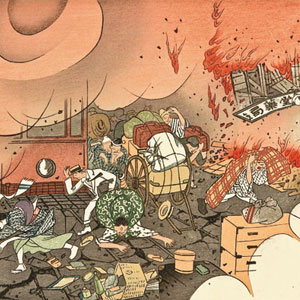1923
The Great Kanto earthquake, as seen by Gotō Shinpei, the Home Minister, was an unparalleled and unprecedented opportunity to reconstruct Tokyo as a showcase of urban modernity and to revitalize the nation (Schencking, 2006, p.834). His ideal plan included building new transport networks, expanding the width of current roads and creating modern water and sewage facilities. It would be a total rebuilding rather than repairing. Politics were greatly involved in the reconstruction process; Gotō's projected budget of 4.1 billion yen ($40,909,800 USD today) was eventually reduced to 468 million yen ($4,669,704 USD today) by 1923. When the reconstruction was completed in 1930, 90 percent of the areas burned by the earthquake's subsequent fires had undergone land readjustment instead of Gotō's aggressive comprehensive redesign.
1945
As the world's first city destroyed by an atomic bomb, the reconstruction of Hiroshima addressed both the pragmatic rebuilding of the city and the wish to memorialize and to reinvent the city's image as Peace City. This led to the enactment of the Hiroshima Peace Memorial City Construction Law on August 6, 1949 by the Diet, under the approval of the U.S. Occupation Headquarters. The tight local and national fiscal situation for rebuilding in Japan was relieved by Occupation authorities who intended to link the atomic bomb to postwar peace. At the same time these authorities enforced censorship of Japanese publications concerning the Atomic Bombing and its effects on communities and lives.
The three most important features of the reconstruction plan in Hiroshima include the 100-meter-wide Peace Boulevard, the Peace Memorial Park and the riverbank greens, designed by the architect Tange Kenzo as part of his proposal to reinvent Hiroshima as a peace city and to raise the citizens' quality of life.
1995
With the Kobe earthquake, there was confusion regarding the roles of government agencies at different administrative levels. No one in Tokyo seemed to be in charge and local requests for aid by Kobe were held up. For instance, a request by the Hyogo prefectural governor for Self-Defense Forces was delayed and coordinating assistance from other prefectures took weeks to finalize (Johnston, 2001). Meanwhile, one of the bright spots to emerge from the quake was the start of a wave of volunteerism that involved people from around Japan gathering in Kobe and its surrounding regions to contribute relief efforts.
The reconstruction following the quake emphasized the concept of community for prompt relief and machi-zukuri, community rebuilding. This small-scale, local initiative of citizen and organizational participation focused on rebuilding local neighborhoods and reviving people's lifestyle. The city of Kobe was known for its inner city urban neighborhoods, characterized by strong social networks. Therefore, government-initiated urban planning, known as toshi-keikaku, was combined with machi-zukuri programs to rebuild the destructed areas as well as restore normalcy to people's life.
2011
An advisory panel, The Reconstruction Design Council, was put together in the disaster's aftermath. In their report to the Prime Minister, they listed "Seven Principles for the Reconstruction Framework," in which community-based reconstruction was emphasized. One defining feature of response to the Great East Japan Earthquake was the systematic bottom-up participation of civil society organizations and small businesses. The prominence of volunteerism after the Kobe earthquake greatly influenced the response to 3.11. Following the disaster, Prime Minister Kan Naoto established a governmental support structure for volunteerism in Northeastern Japan, an example of the evolution of a state-civilian relationship since 1995 (Kingston, 2012, p. 9). On the other hand, the ineffective leadership, the inability of the officials to formulate coherent relief policies, and the lack of transparency in reporting the Fukushima crisis led to nationwide protests and distrust in the government (Kingston, 2012, p. 6, 7). While the national government failed to provide hope and support for its people, the Imperial Family continued to be the spiritual support in modern society. Emperor Akihito made an unprecedented televised address to his nation, urging people to help each other in difficult times. The Royal couple's visits to the disaster-stricken areas also boosted hope among the victims.
